By Zach Watkins
Defensive Coordinator/Secondary
Washburn University (KS)
Twitter: @Zach_Watkins
Our base defensive structure here at Washburn University is the 4-2-5 and our base coverage is cover 4. We feel that cover 4 gives us the flexibility, disguise, and effectiveness to be our "go-to" coverage. Like most teams that base out of quarters, our scheme has a variety of checks and adjustments that allow us to look very multiple to opposing offenses while maintaining simplicity for our players. Quarters also allows us to play the best coverage possible regardless of what the offense aligns in. A defensive coordinator's game plan must always include how to defend 3x1 sets the opponent utilizes. Many offenses get into 3x1 sets to isolate their best WR on the backside, usually being singled up vs. the boundary CB. Using quarters coverage and our away side "tags", we have confidence in how we combat 3x1 offensive sets.
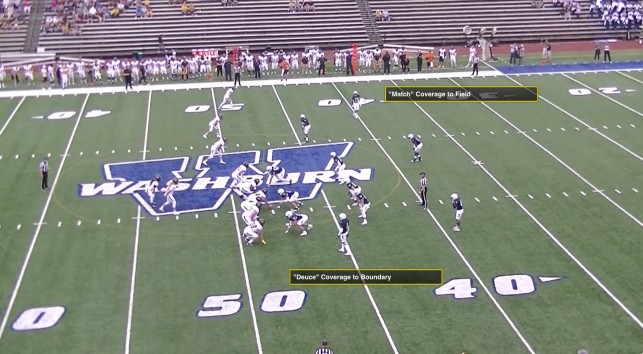
STRUCTURE
In our 4-2-5 structure, we have a "read-side" and an "away side". The read side is the side of the offensive formation that has the most receivers (or most dangerous threats based on game plan). The free safety (FS) and star (*) align to the read side. The away side is the side of the offensive formation that has a lesser number of receivers (or less dangerous threats based on game plan). The stud (ST) aligns to the away side. Mike (M) aligns to the front strength and the Will (W) aligns away from front strength.
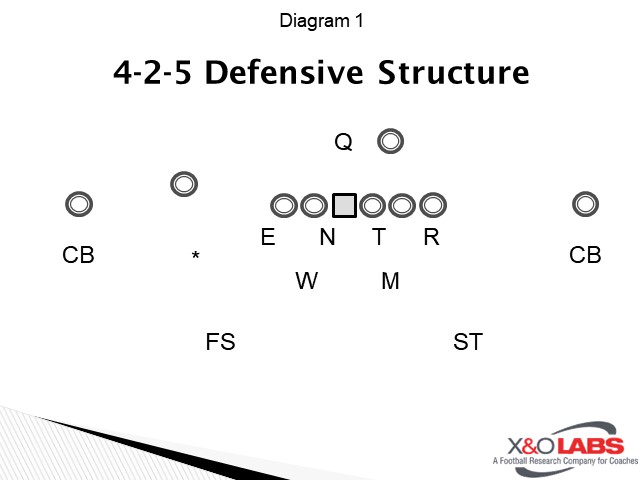
We call our front strength away from three WRs (under front) so that the Will backer can expand out of the box and get himself out of his run/pass conflict.
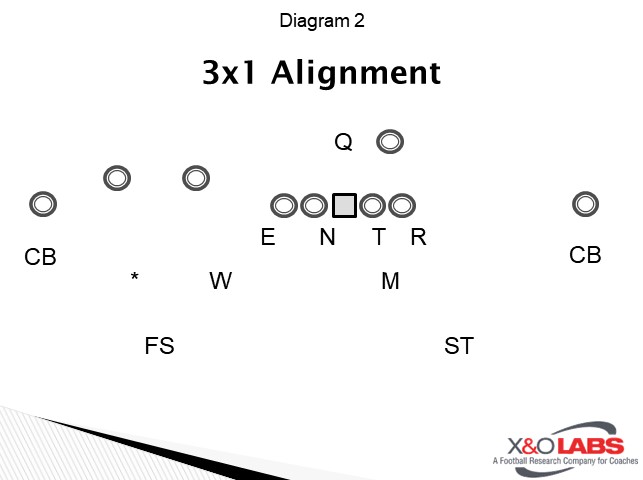
With that terminology, we will discuss “box” coverages to the read side and “triangle” coverages (“tags”, when discussing cover 4) to the away side vs. 3x1 formations.
“BOX” and “TRIANGLE” COVERAGES
We define “box “coverage as four defenders over three offensive players. We define “triangle” coverage as three defenders over two offensive players. We call these variations of triangle coverages “tags” when talking about quarters specifically. In Diagram 3, the read side CB, *, FS, and W are playing the box coverage and the away side CB, M, and ST are playing the triangle coverage. Anytime the ST is not involved in the read side box coverage, (spinning to the read side, poaching #3 vertical, etc.) any of our triangle coverages can be played on the away side.
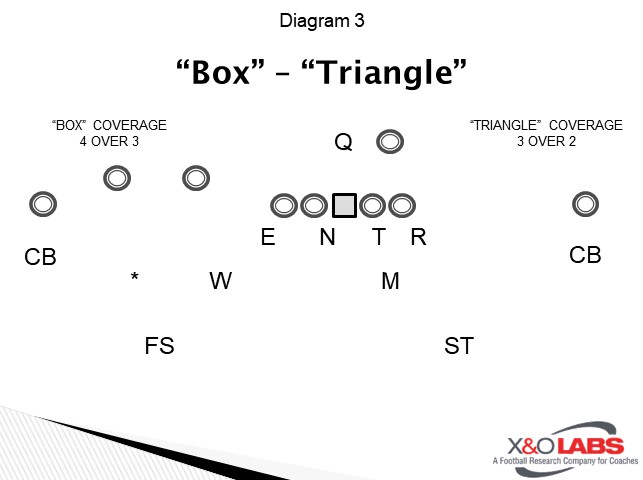
As you have realized, box coverages are always played to the read side and triangle coverages are usually played to the away side. Triangle coverages can be played to the read and away side if the formation isn’t 3x1. For this report, I will only discuss two box coverages that we utilize so that I can elaborate on the away side “tags”.
BOX COVERAGES
MATCH
Our preferred box coverage is “match”. Most coaches know it as a variation on “Palms” or “2 Read”. Simply put, CB plays man to man on #1. The *, FS, and W are playing a 2-read concept on #2 and #3.
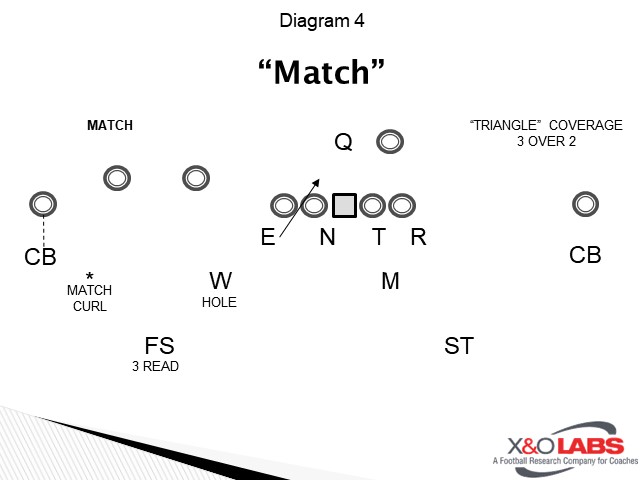
The aligns outside of #2, usually 5-7 yards deep, and is termed a "match curl" player. The match curl player plays all routes of #2 unless #3 gets width (under LBs, usually 5 yards), then he must leverage/man #3. If #3 doesn't get the width, the * is man on #2. The FS is termed a "3 read" player. The 3 read player reads #3 just like in our quarters' scheme. If #3 is vertical past LB depth, FS plays him, man. If #3 goes out or under, (under LBs, usually 5 yards) he becomes a read player. If #3 goes out, FS will weave and play #2. If #3 goes under, FS will play curl/dig/post (CDP) of #2 just like in quarters. W will play the “hole”. The hole player plays #3 shallow and will disrupt/re-route #3 on any vertical. Depending on the away side “tag”, W’s responsibility may change to a cut/wall player.
STRESS
The second box coverage we install is “stress”. Stress is a way to play zone coverage to the read side and force the QB to make a very long throw to the read side #1, something most offenses aren’t willing or able to do.
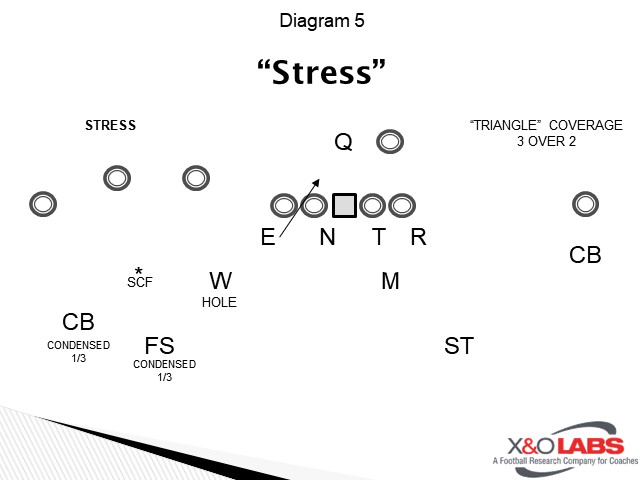
The rules for stress are complementary to other coverages we run. The CB and FS are playing condensed 1/3s over the 3 WRs. The * is a seam/curl/flat player (SCF). W is again the "hole" player. The * and W MUST disrupt and re-route the #2 and #3 WRs. The read side flat will be a late break and rally, forcing the QB to make the long throw to the field. Depending on the away side “tag”, W’s responsibility may change to a cut/wall player.
These coverages can be played interchangeably to the read side, with no effect on which tag you choose to play to the away side.
TRIANGLE COVERAGES - “TAGS”
Once we have determined what our read side box coverages will be, we can dive into the expansive menu of triangle coverage “tags”. The only thing limiting what types of tags we play is if the ST “spins” to the read side and cannot be involved in the triangle coverage. We break our tags down into two categories: coverage tags and pressure tags.
COVERAGE TAGS
DEUCE
Deuce is one of our primary tags. Deuce is cover 2 on the away side. CB, ST, and M are playing their normal cover 2 drops. CB's technique is jam/funnel/ride (JFR) and plays the flat. M is a seam dropper, rerouting any WR out of the "seam" (two yards on each side of the hash). ST plays the true deep 1/2. With only one WR to the away side, the CB can play heavy on #1 until a receiver gets width to his flat.
Defensive Coordinator/Secondary
Washburn University (KS)
Twitter: @Zach_Watkins
Our base defensive structure here at Washburn University is the 4-2-5 and our base coverage is cover 4. We feel that cover 4 gives us the flexibility, disguise, and effectiveness to be our "go-to" coverage. Like most teams that base out of quarters, our scheme has a variety of checks and adjustments that allow us to look very multiple to opposing offenses while maintaining simplicity for our players. Quarters also allows us to play the best coverage possible regardless of what the offense aligns in. A defensive coordinator's game plan must always include how to defend 3x1 sets the opponent utilizes. Many offenses get into 3x1 sets to isolate their best WR on the backside, usually being singled up vs. the boundary CB. Using quarters coverage and our away side "tags", we have confidence in how we combat 3x1 offensive sets.

STRUCTURE
In our 4-2-5 structure, we have a "read-side" and an "away side". The read side is the side of the offensive formation that has the most receivers (or most dangerous threats based on game plan). The free safety (FS) and star (*) align to the read side. The away side is the side of the offensive formation that has a lesser number of receivers (or less dangerous threats based on game plan). The stud (ST) aligns to the away side. Mike (M) aligns to the front strength and the Will (W) aligns away from front strength.

We call our front strength away from three WRs (under front) so that the Will backer can expand out of the box and get himself out of his run/pass conflict.

With that terminology, we will discuss “box” coverages to the read side and “triangle” coverages (“tags”, when discussing cover 4) to the away side vs. 3x1 formations.
“BOX” and “TRIANGLE” COVERAGES
We define “box “coverage as four defenders over three offensive players. We define “triangle” coverage as three defenders over two offensive players. We call these variations of triangle coverages “tags” when talking about quarters specifically. In Diagram 3, the read side CB, *, FS, and W are playing the box coverage and the away side CB, M, and ST are playing the triangle coverage. Anytime the ST is not involved in the read side box coverage, (spinning to the read side, poaching #3 vertical, etc.) any of our triangle coverages can be played on the away side.

As you have realized, box coverages are always played to the read side and triangle coverages are usually played to the away side. Triangle coverages can be played to the read and away side if the formation isn’t 3x1. For this report, I will only discuss two box coverages that we utilize so that I can elaborate on the away side “tags”.
BOX COVERAGES
MATCH
Our preferred box coverage is “match”. Most coaches know it as a variation on “Palms” or “2 Read”. Simply put, CB plays man to man on #1. The *, FS, and W are playing a 2-read concept on #2 and #3.

The aligns outside of #2, usually 5-7 yards deep, and is termed a "match curl" player. The match curl player plays all routes of #2 unless #3 gets width (under LBs, usually 5 yards), then he must leverage/man #3. If #3 doesn't get the width, the * is man on #2. The FS is termed a "3 read" player. The 3 read player reads #3 just like in our quarters' scheme. If #3 is vertical past LB depth, FS plays him, man. If #3 goes out or under, (under LBs, usually 5 yards) he becomes a read player. If #3 goes out, FS will weave and play #2. If #3 goes under, FS will play curl/dig/post (CDP) of #2 just like in quarters. W will play the “hole”. The hole player plays #3 shallow and will disrupt/re-route #3 on any vertical. Depending on the away side “tag”, W’s responsibility may change to a cut/wall player.
STRESS
The second box coverage we install is “stress”. Stress is a way to play zone coverage to the read side and force the QB to make a very long throw to the read side #1, something most offenses aren’t willing or able to do.

The rules for stress are complementary to other coverages we run. The CB and FS are playing condensed 1/3s over the 3 WRs. The * is a seam/curl/flat player (SCF). W is again the "hole" player. The * and W MUST disrupt and re-route the #2 and #3 WRs. The read side flat will be a late break and rally, forcing the QB to make the long throw to the field. Depending on the away side “tag”, W’s responsibility may change to a cut/wall player.
These coverages can be played interchangeably to the read side, with no effect on which tag you choose to play to the away side.
TRIANGLE COVERAGES - “TAGS”
Once we have determined what our read side box coverages will be, we can dive into the expansive menu of triangle coverage “tags”. The only thing limiting what types of tags we play is if the ST “spins” to the read side and cannot be involved in the triangle coverage. We break our tags down into two categories: coverage tags and pressure tags.
COVERAGE TAGS
DEUCE
Deuce is one of our primary tags. Deuce is cover 2 on the away side. CB, ST, and M are playing their normal cover 2 drops. CB's technique is jam/funnel/ride (JFR) and plays the flat. M is a seam dropper, rerouting any WR out of the "seam" (two yards on each side of the hash). ST plays the true deep 1/2. With only one WR to the away side, the CB can play heavy on #1 until a receiver gets width to his flat.









